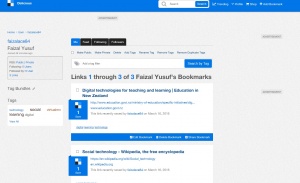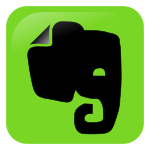VirtualMV/Digital Learning Technologies/Social/Other
| Digital Learning Technologies | ||
|---|---|---|
| Social technologies | eMail | Discussion boards | Instant Messaging | Facebook | Linked-in | Pinboards | Web conferencing | Other | |
| Others | Blogs/Microblogs | |
Contents
- 1 Overview
- 2 Examples
- 3 Social Media in Education
- 4 Trends in Social Media Platforms for Learning
- 4.1 Diigo
- 4.2 Ning ( http://www.ning.com/ )
- 4.3 VoiceThread
- 4.4 Sophia ( http://www.sophia.org/)
- 4.5 Edmodo( http://www.edmodo.com/)
- 4.6 Teamie(http://theteamie.com)
- 4.7 Schoology (http://www.schoology.com/)
- 4.8 Wiki & Google as Learning and teaching tool
- 4.9 Virtual Reality
- 4.10 How organizations are using social media for learning
- 4.11 Microsoft 2020 technology future vision
- 5 Social Media for Education
- 6 Mobile Technology for E-learning
- 7 MoxieSoftware
- 8 Open Source Q & A (OSQA) http://www.osqa.net/
- 9 Twitch.tv live streaming
- 10 Delicious.com (http://delicious.com)
- 11 Evernote (https://evernote.com/)
- 12 Issues
Overview
Examples
Clicker app
Free clicker app for IoS mobile or accessible from any web browser
- https://itunes.apple.com/us/app/teacher-clicker-socrative/id477620120?mt=8%20 for the teacher app
- https://itunes.apple.com/us/app/student-clicker-socrative/id477618130?mt=8 for the student app
- Multichoice, t/f/ short answer, on the fly or pre made.Reporting/graph features.
100 Examples of the Use of Social Media for Learning
100 Plus examples of use of Social Media for Learning. Centre for Learning and Performance Technologies Website 2013, Retrieved 18/03/2013 from http://c4lpt.co.uk/social-learning-handbook/100-examples-of-use-of-social-media-for-learning/[1]
Microsoft Vision of the Classroom of the Future
This YouTube video has interesting technological aspects in it, not so much a 'Social' video, but interesting.
Microsoft Vision of the Classroom of the Future: Video retrieved March 18, 2013, from Vision of the future
Google Docs.
Google Docs is a Collaborative software created by Google, and was released under the name of Google Docs on February 2007.
Google Docs Currently has four types of collaborative programs they are:
- Docs
- Sheets
- Forms
- Slides
With the usage of Google plus social media, Google docs allows multiple users to share and create documents real-time. Users editing the documents can be seen under different highlighted colours so that if something that was changed and is not suitable can be removed or changed and the original editor can be notified.
This web tool has allowed groups and teachers to communicate with each other in real-time so that both students and groups can be kept up to date with what is required.
Further information about Google docs can be found from their about page: https://www.google.co.nz/docs/about/[2]
Phyzard (talk) Saying big and fancy words does not make you a smart person. 02:41, 19 March 2015 (UTC)
Social Media in Education
How Social Media is utilised in Education.
Social Media in Education - Teaching Digital Natives: Video retrieved March 18, 2013, from Teaching Digital Natives
Trends in Social Media Platforms for Learning
Trends in Social Media Platforms for Learners: Video retrieved March 18, 2013, from Trends
Diigo
A web page annotation tool allows for sharing comments
Ning ( http://www.ning.com/ )
Ning is an online platform for people and organizations to create custom social networks, launched in October 2005.Ning offers customers the ability to create a community website with a customized appearance and feel, feature sets such as photos, videos, forums and blogs, and the service layers in support for “Like”, integration with Facebook, Twitter, Google and Yahoo!.(Ning (website), 2012)[3]
VoiceThread
Voice Thread is a web based collaborative and interactive slide show application. Once a Voice Thread is created, it offers several ways for students to interact with its content. By clicking a comment button and choosing a method of commenting (voice, text, video or drawing) the student can respond in an easy and intuitive manner. Each response is added to the time-line, producing a multimedia presentation whereby the students’ contribution form part of the final production. Images, PowerPoint slides and word documents can be imported to Voice Thread and commented on equally. Knowledge is created, aggregated and shared.
Use at EIT
In the process of re-development of a course to deliver in a blended environment in 2012 (at EIT), a need was identified for a method by which the students could provide online multi-modal (text, voice or video) responses to questions and discussion topics and in such a way that would build and expand on the prior contributions of others. The need to provide a method for oral contribution and interaction and the importance of this in building whanaungatanga was also identified. It is also acknowledged that for this to be successful, the tutor should ideally have the ability to provide formative feedback in a similar multi-modal manner. Furthermore, the importance of building ritual into an online course was identified during TiLT blended training as a method by which familiarity and comfort was achieved within the online environment.
VoiceThread is now successfully being used across a range of papers in the Bachelor of Applied Social Sciences program. Weekly questions for reflection or a topic for discussion are being formulated by the tutor and uploaded to Voice Thread for response by the students. These questions are on the topic of learning for that week or a current issue that relates to social work and the relevant course. The learners, by replying and adding to the presentation, will construct a shared narrative about that particular topic or question.
VoiceThread Issues
- User technical skills - need to be able to use a webcam and microphone on the computer (not required for text only input)
- Limited to 3 threads on a free account (K - 12) educators can score a 50 Thread account, others need to pay.
- Web-based tools come and go (risk)
- Paid accounts can download and save threads, free accounts saved in the cloud
- Varying degrees of access from public to private (more options and restrictions on paid accounts)
- Flash based (although app available for ipad/iphone/mobile)
- Integrates nicely with LMS (Moodle-plugin)
VoiceThread is available as an app for your mobile or tablet device.
Sophia ( http://www.sophia.org/)
"Sophia is a social teaching and learning network. It's where you can teach what you know and learn what you don't. Whether you're a high school student, college student, teacher, professor, tutor or parent, Sophia makes knowledge easier to share, easier to find, and easier to organize. And it's free (Sophia (website), 2011)." [4]
Edmodo( http://www.edmodo.com/)
Edmodo [5] is a social teaching and learning technology that can be used within and across institutions, especially schools, that encourages Facebook-like interactions. "Classrooms" are linked or assembled by a group code or password. This means they can be geographically separated.Teachers are able to set course work or assignments from sources and contacts globally. Forums allow group discussions in much the same way as EITOnLine. Assignments or tasks may be set and marked with results posted on line.
Teamie(http://theteamie.com)
Teamie harnesses the power of social networking to make learning fun, collaborative and engaging. Teamie create a safe & secure network for teachers and students to interact and learn.
Schoology (http://www.schoology.com/)
Schoology [7] Schoology is an online learning, classroom management, and social networking platform that offers online courses and helps teachers manage their lesson plans and students interact with their professors and fellow students. It is one of many such platforms; see http://www.onlinecolleges.net/2012/04/18/take-notes-online-learning-platforms-continue-to-expand-the-classroom/ for further information. [8]
Schoology Introduction Video retrieved March 15, 2013, from Schoology
Wiki & Google as Learning and teaching tool
Although a similar type of education is done by us at EIT, Hawke's Bay, this video if National University of Singapore using wiki and google maps very efficiently for the purpose of education
Buzzed 2013 Releasing the Reins: Technologies that put Students in Charge video retrieved March 15, 2013, from Releasing the reins
Instead of using socially constructed technologies, we also can use a name known to one and all but its technology used by seldom.
Google sites, This video shows the use of Google sites for the purpose of learning.
Virtual Reality
Vritual reality based-learning improves learner's attention, increases motivation, encourages collaboration and develops creativity. [9]Example: Second Life Second Life is a simulated online app giving a user the chance to be as another persona in a virtual world. Users create their own avatars as representation of themselves and explore the grid. A users, or resident as they are called, can interact with other residents and participate in group activities, create, trade and shop for virtual properties and services.[10]
Jjtrocino (talk) 07:04, 11 March 2016 (UTC)
Digital social media technologies
Within the virtual world Second Life the main type of communication between residents was messaging via a chat bar, but today, use video streaming, video conferencing, group messaging and most recently in-world to out-world mobile device connections, (two way messaging between the resident in-world and somebody who is not directly in-world but is communicating through their mobile device) this has greatly increased Second Life users ability to communicate.
Example:
Social media in-world
Residents may open a group message chat bar and talk openly to each other while having multiple private chat bars open where they message friends simultaneously, the resident may also be streaming a 2 way video connection with another resident, maybe to watch a movie together that they both have open on another tab, the resident may also be attending a video conference because their avatar is in one of many in-world educational institutes, all this while texting from in world either through the chat bar, a virtual pc or the residents virtual mobile device to some one who is not even at a pc but actually sitting in McDonald's eating a burger.
Education
Within the virtual world you can find many educational institutes many of which are certified and in use as official representatives of their physical counterparts, you will find tutors and students from around the world taking advantage of the in-world social media technology to improve their educational resources.
Here is a list of [1]educational institutes that have registered on Second Life
Leading examples of education and non profit[2] organisations
Con Maurirere BCS Student C Maurirere (talk) 09:07, 21 March 2016 (UTC)
How organizations are using social media for learning
There are some example of how organizations are using social media for learning. http://c4lpt.co.uk/social-learning-handbook/examples-of-social-media-for-learning/
Microsoft 2020 technology future vision
This YouTube video shows the future of human social network technologies.
Microsoft 2020 technology future vision: Video retrieved March 24, 2013, from Future vision
Social Media for Education
How Social Media is utilised in Education.
Social Media for Education: Video retrieved March 24, 2013, from Social Media for Education
Mobile Technology for E-learning
Edu Alert education service http://edualert.in/
Edu Alert is a web learning experiment in a developing country like India.
MoxieSoftware
http://www.moxiesoft.com/
Moxie Software is the only customer centric enterprise social software company that enables companies – in a single suite— to connect employees, customers and partners to engage in business, share knowledge and collaborate.
Moxie Software’s customer centric, enterprise social software is bringing positive changes to organizations in various industry segments.
Flexible Deployment
Moxie Software offers deployment options that support the unique requirements of enterprises. Whether seeking a traditional on-premise configuration, a Virtual Private Cloud environment or complete, secure, cloud-based SaaS, Moxie delivers social software that enables companies to engage customers and employees – without being constrained by any single deployment method.
Market Leadership
Many of the Global 2000 companies rely on Moxie Software to engage with customer, partners and employees. Moxie Software’s intuitive design – developed in collaboration with world-renowned design and innovation firm IDEO – delivers the most comprehensive solution that fulfils the promise of enterprise collaboration.
Thought Leadership
Moxie Insight thought leaders include Don Tapscott, world-renowned author of fourteen books including Wikinomics and Macrowikinomics, and Tammy Erickson, a frequent contributor to Harvard Business Review and author of Workforce Crisis and What’s Next, Gen X?.
Strong Financial Position
Moxie is a privately-held company, extremely well-funded with venture and private equity from a group of experienced investors including Oak Investment Partners and Foundation Capital. In 2011, the company grew 30 percent and increased its recurring revenue over 40 percent.
Open Source Q & A (OSQA) http://www.osqa.net/
OSQA is the open-source Q&A platform that the professors who taught Stanford's AI class used to develop their proprietary, self-moderated Q&A platform, Aiqus, for their ground-breaking online course. (EdLab Review: OSQA, 2011) [11]. The general idea with these community Q&A systems is that anyone can pose a question and the open community can get involved with providing answers (learners, tutors, AVIs general public etc). Contributors to the FAQ site earn "karma" points for various activities and as your "karma" increases, your trust in the community grows, resulting in access to more features of the software which require a higher level of trust. The technology provided a mechanism to manage the workload of the lecturers who only responded to the questions which filtered through to the top. In the system, students can answer each others questions providing another dimension of peer-2-peer support.
Twitch.tv live streaming
Twitch allow an individual to stream what they are doing to the whole world. This tool is mainly used for streaming games, but theoretically can be used to broadcast anything. Content on the site can either be viewed live, or viewed on an on-demand basis.[12] This can be an incredibly powerful tool that lets anyone teach any number of people anything that they want, at anytime, anywhere in the world. Using twitch requires an external program to be able to stream. Popular programs are Open broadcast software (OBS) and xSplit.
Twitch has an inbuilt chat session allowing the host/streamer and viewers to chat through text. The site is available on multiple platforms including IOS and android, making it a popular choice for streaming.
Mgrant (talk) 02:47, 19 March 2015 (UTC)
Delicious.com (http://delicious.com)
Delicious.com is a "social bookmarking" site which allows educators to create a "searchable" page of links gathered from the Web. These can be interesting links related to the course taught and students can create accounts on Delicious.com and given access to the page.
Something to ponder upon:
Has social bookmarking lost its lustre?[13]
Faizalace84 21:06, 16 March 2016 (UTC)
Evernote (https://evernote.com/)
What is Evernote:
Evernote is a suite of software and services designed for notetaking and archiving. A “note” can be a piece of formattable text, a full webpage or webpage excerpt, a photograph, a voice memo, or a handwritten “ink” note. Evernote is the modern workspace that syncs between all of your devices. Work everywhere and stay productive:
- Write notes, checklists, and research
- Organize web articles, docs, and photos
- Discuss your work with others, right within the app
Using Evernote for teaching and learning
Evernote is a great application for students, it can help organize our work, and everything we put on Evernote can be synchronized between our phones and computers automatically. It helps us to:
- take notes
- track tasks & assignments
- save things we find online and share them with others
As a teacher, Evernote's usefulness can range from planning a course to delivering a lesson plan to capturing feedback after class:
- Plan and organize your classes with tags
- share a notebook with your class
- keep your extracurriculars in order
- Help Students show their work
- Facilitate 'Reaction' assignments
- Provide audio instructionsetc.
References:
Ifttt(website). Evernote Channel. (n.d.). Retrieved March 16, 2016, from https://ifttt.com/evernote
--Bonniening (talk) 22:14, 16 March 2016 (UTC)
Issues
 References
References
- ↑ http://c4lpt.co.uk/social-learning-handbook/100-examples-of-use-of-social-media-for-learning/
- ↑ https://www.google.co.nz/docs/about/
- ↑ Ning (website). (2012, March 2). In Wikipedia, The Free Encyclopedia. Retrieved 04:05, March 4, 2012, from http://en.wikipedia.org/w/index.php?title=Ning_(website)
- ↑ Sophia (website). (2011). Teach what you know learn what you don't. Retrieved March 10, 2012, from http://www.sophia.org (website)
- ↑ Edmodo (website). (2013). What is Edmodo?? Retrieved March 11, 2013, from http://www.edmodo.com (website)
- ↑ Teamie (website). (2010). The Teamie. Retrieved 01:32, March 12, 2013, from http://www.theteamie.com(website)
- ↑ Schoology (website). (2013). Schoology Introduction. Retrieved March 15, 2013, from http://www.schoology.com (website)
- ↑ Online Colleges. Retrieved March 15, 2013 from http://www.onlinecolleges.net
- ↑ Abrosimova, K. Hypergrid Business. 5 ways virtual reality will change education. Retrieved from http://www.hypergridbusiness.com/2014/09/5-ways-virtual-reality-will-change-education/
- ↑ Second Life (2016). Retrieved from http://secondlife.com/
- ↑ EdLab Review: OSQA (2011). Retrieved from http://edlab.tc.columbia.edu/index.php?q=node/6968
- ↑ Twitch.tv. (2015, March 18). In Wikipedia, The Free Encyclopedia. Retrieved 02:38, March 19, 2015, from http://en.wikipedia.org/w/index.php?title=Twitch.tv&oldid=651867088
- ↑ http://socialbarrel.com/is-social-bookmarking-still-relevant-in-todays-digital-marketing/101813/
|
virtualMV | Superquick wiki guide | Please give me some feedback |
VirtualMV/Digital Learning Technologies/Social/Other. (2024). In WikiEducator/VirtualMV wiki. Retrieved November 21, 2024, from http:https://wikieducator.org/VirtualMV/Digital_Learning_Technologies/Social/Other (zotero)
|




